Abstract
Selenium and vitamin E exert powerful effects in reducing acute or chronic methylmercury toxicity. Levels of selenium normally found in foods (below 1 ppm) delay the onset of toxic signs caused by much higher levels of methylmercury. Tissue levels of mercury in selenium-supplemented animals equal or exceed those found in animals given methylmercury alone. Selenium does not appear to act by simply modifying intake, absorption, excretion, or distribution of methylmercury, and direct effects of both selenium and vitamin E have been observed in vitro when methylmercury was added to cultured nervous tissue cells. The only established functions for selenium and vitamin E in animals are related to the prevention of oxidative damage in tissues. To encompass the protective effects of selenium and vitamin E and to explain other toxicological aspects of methylmercury and other alkylmetals, a new hypothesis is proposed: The toxicity of the alkylmetals is not caused soley by the intact molecule, but also involves free radicals formed by homolytic fission of the carbon-metal bond.
Full text
PDF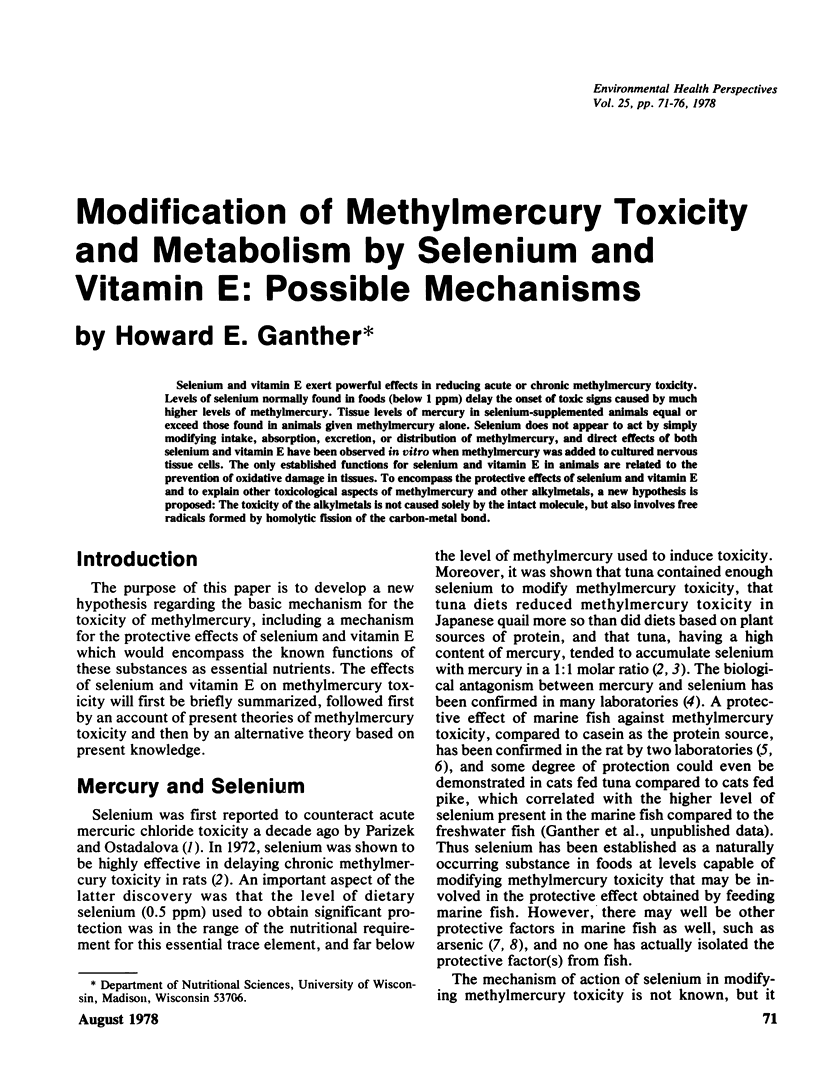
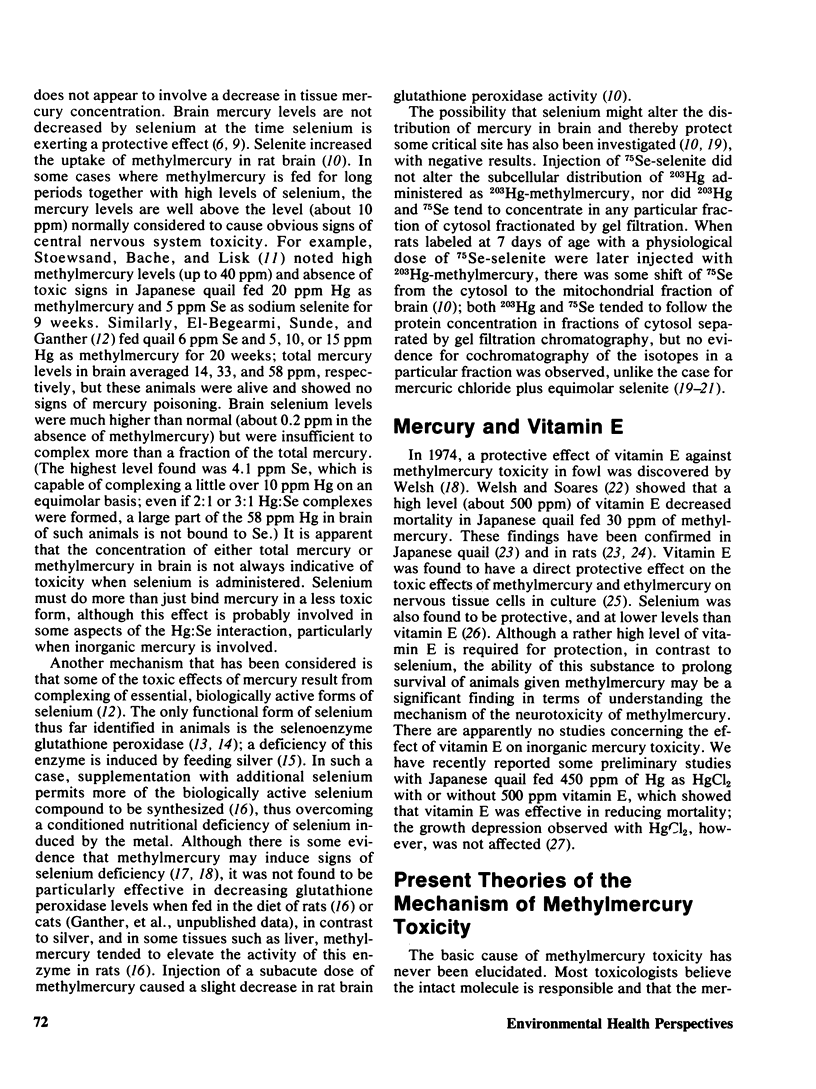

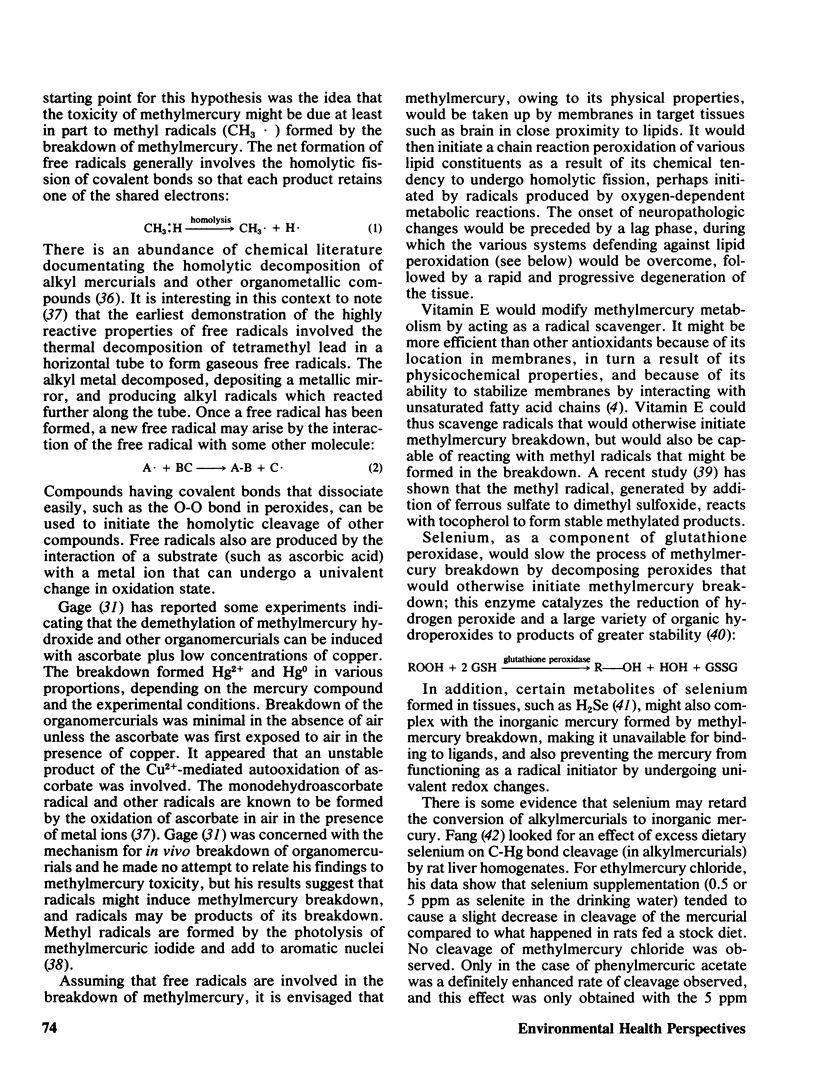
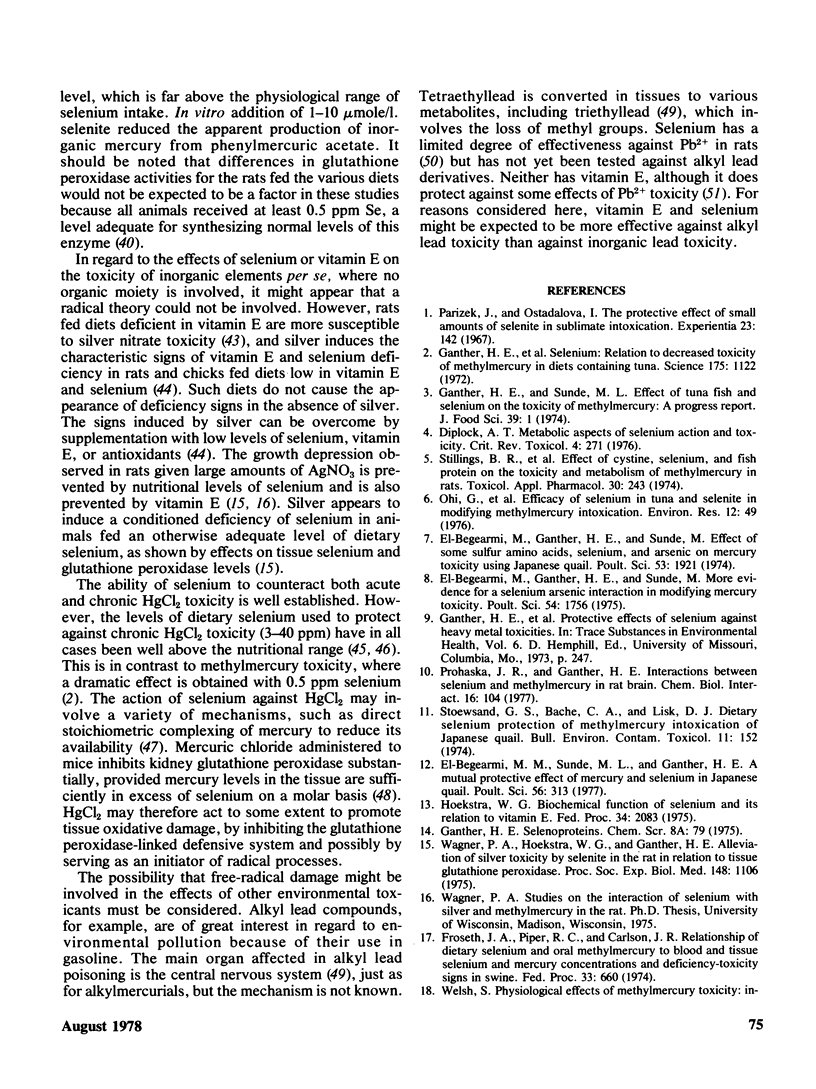
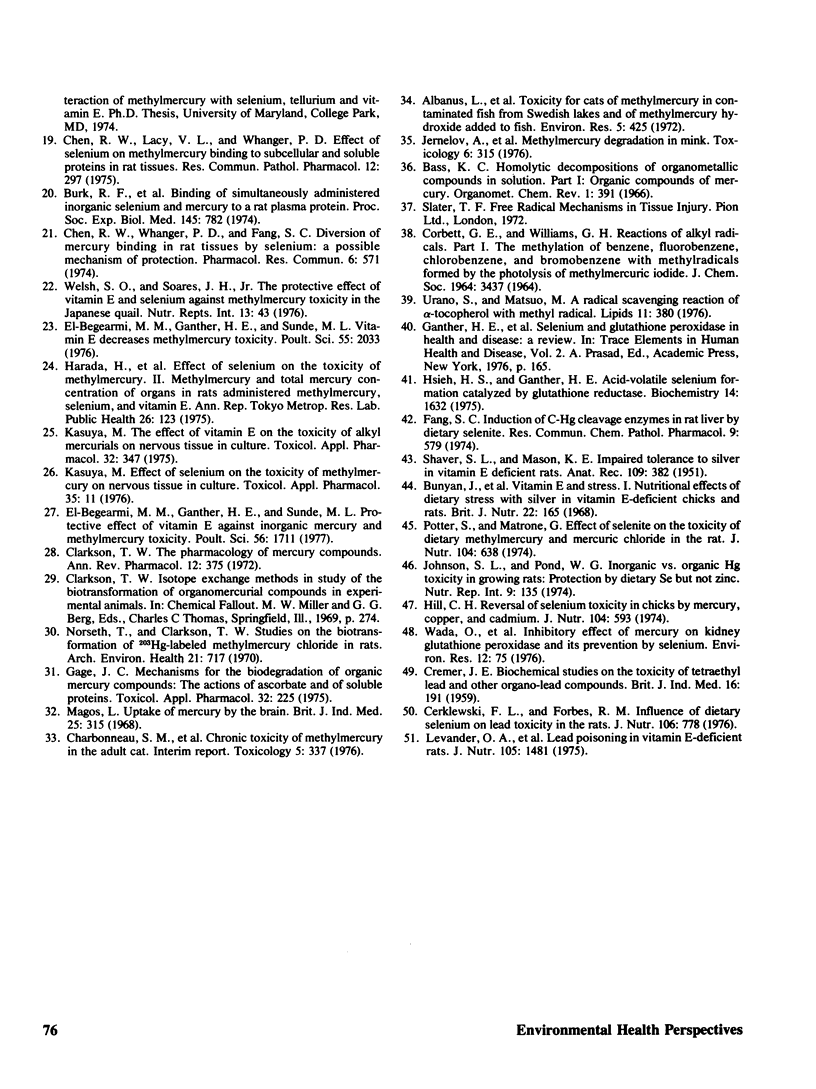
Selected References
These references are in PubMed. This may not be the complete list of references from this article.
- Albanus L., Frankenberg L., Grant C., von Haartman U., Jernelöv A., Nordberg G., Rydälv M., Schütz A., Skerfving S. Toxicity for cats of methylmercury in contaminated fish from Swedish lakes and of methylmercury hydroxide added to fish. Environ Res. 1972 Dec;5(4):425–442. doi: 10.1016/0013-9351(72)90044-8. [DOI] [PubMed] [Google Scholar]
- Bunyan J., Diplock A. T., Cawthorne M. A., Green J. Vitamin E and stress. 8. Nutritional effects of dietary stress with silver in vitamin E-deficient chicks and rats. Br J Nutr. 1968 May;22(2):165–182. doi: 10.1079/bjn19680023. [DOI] [PubMed] [Google Scholar]
- Burk R. F., Foster K. A., Greenfield P. M., Kiker K. W., Hannon J. P. Binding of simultaneously administered inorganic selenium and mercury to a rat plasma protein. Proc Soc Exp Biol Med. 1974 Mar;145(3):782–785. doi: 10.3181/00379727-145-37894. [DOI] [PubMed] [Google Scholar]
- CREMER J. E. Biochemical studies on the toxicity of tetraethyl lead and other organo-lead compounds. Br J Ind Med. 1959 Jul;16:191–199. doi: 10.1136/oem.16.3.191. [DOI] [PMC free article] [PubMed] [Google Scholar]
- Cerklewski F. L., Forbes R. M. Influence of dietary selenium on lead toxicity in the rat. J Nutr. 1976 Jun;106(6):778–783. doi: 10.1093/jn/106.6.778. [DOI] [PubMed] [Google Scholar]
- Charbonneau S. M., Munro I. C., Nera E. A., Armstrong F. A., Willes R. F., Bryce F., Nelson R. F. Chronic toxicity of methylmercury in the adult cat. Interim report. Toxicology. 1976 Mar;5(3):337–349. doi: 10.1016/0300-483x(76)90052-4. [DOI] [PubMed] [Google Scholar]
- Chen R. W., Whanger P. D., Fang S. C. Diversion of mercury binding in rat tissues by selenium: a possible mechanism of protection. Pharmacol Res Commun. 1974 Dec;6(6):571–579. doi: 10.1016/s0031-6989(74)80006-8. [DOI] [PubMed] [Google Scholar]
- Clarkson T. W. The pharmacology of mercury compounds. Annu Rev Pharmacol. 1972;12:375–406. doi: 10.1146/annurev.pa.12.040172.002111. [DOI] [PubMed] [Google Scholar]
- Diplock A. T. Metabolic aspects of selenium action and toxicity. CRC Crit Rev Toxicol. 1976 Feb;4(3):271–329. doi: 10.1080/10408447609164016. [DOI] [PubMed] [Google Scholar]
- El-Begearmi M. M., Sunde M. L., Ganther H. E. A mutual protective effect of mercury and selenium in Japanese quail. Poult Sci. 1977 Jan;56(1):313–322. doi: 10.3382/ps.0560313. [DOI] [PubMed] [Google Scholar]
- Fang S. C. Induction of C-hg cleavage enzymes in rat liver by dietary selenite. Res Commun Chem Pathol Pharmacol. 1974 Nov;9(3):579–582. [PubMed] [Google Scholar]
- Gage J. C. Mechanisms for the biodegradation of organic mercury compounds: the action of ascorbate and of soluble proteins. Toxicol Appl Pharmacol. 1975 May;32(2):225–238. doi: 10.1016/0041-008x(75)90215-x. [DOI] [PubMed] [Google Scholar]
- Ganther H. E., Goudie C., Sunde M. L., Kopecky M. J., Wagner P. Selenium: relation to decreased toxicity of methylmercury added to diets containing tuna. Science. 1972 Mar 10;175(4026):1122–1124. doi: 10.1126/science.175.4026.1122. [DOI] [PubMed] [Google Scholar]
- Hill C. H. Reversal of selenium toxicity in chicks by mercury, copper, and cadmium. J Nutr. 1974 May;104(5):593–598. doi: 10.1093/jn/104.5.593. [DOI] [PubMed] [Google Scholar]
- Hoekstra W. G. Biochemical function of selenium and its relation to vitamin E. Fed Proc. 1975 Oct;34(11):2083–2089. [PubMed] [Google Scholar]
- Hsieh H. S., Ganther H. E. Acid-volatile selenium formation catalyzed by glutathione reductase. Biochemistry. 1975 Apr 22;14(8):1632–1636. doi: 10.1021/bi00679a014. [DOI] [PubMed] [Google Scholar]
- Jernelöv A., Johansson A. H., Sörensen L., Svenson A. Methyl mercury degradation in mink. Toxicology. 1976 Nov-Dec;6(3):315–321. doi: 10.1016/0300-483x(76)90035-4. [DOI] [PubMed] [Google Scholar]
- Kasuya M. Effect of selenium on the toxicity of methylmercury on nervous tissue in culture. Toxicol Appl Pharmacol. 1976 Jan;35(1):11–20. doi: 10.1016/0041-008x(76)90106-x. [DOI] [PubMed] [Google Scholar]
- Kasuya M. The effect of vitamin E on the toxicity of alkyl mercurials on nervous tissue in culture. Toxicol Appl Pharmacol. 1975 May;32(2):347–354. doi: 10.1016/0041-008x(75)90225-2. [DOI] [PubMed] [Google Scholar]
- Levander O. A., Morris V. C., Higgs D. J., Ferretti R. J. Lead poisoning in vitamin E-deficient rats. J Nutr. 1975 Nov;105(11):1481–1485. doi: 10.1093/jn/105.11.1481. [DOI] [PubMed] [Google Scholar]
- Magos L. Uptake of mercury by the brain. Br J Ind Med. 1968 Oct;25(4):315–318. doi: 10.1136/oem.25.4.315. [DOI] [PMC free article] [PubMed] [Google Scholar]
- Norseth T., Clarkson T. W. Studies on the biotransformation of 203Hg-labeled methyl mercury chloride in rats. Arch Environ Health. 1970 Dec;21(6):717–727. doi: 10.1080/00039896.1970.10667325. [DOI] [PubMed] [Google Scholar]
- Parízek J., Ostádalová I. The protective effect of small amounts of selenite in sublimate intoxication. Experientia. 1967 Feb 15;23(2):142–143. doi: 10.1007/BF02135970. [DOI] [PubMed] [Google Scholar]
- Potter S., Matrone G. Effect of selenite on the toxicity of dietary methyl mercury and mercuric chloride in the rat. J Nutr. 1974 May;104(5):638–647. doi: 10.1093/jn/104.5.638. [DOI] [PubMed] [Google Scholar]
- Stoewsand G. S., Bache C. A., Lisk D. J. Dietary selenium protection of methylmercury intoxication of Japanese quail. Bull Environ Contam Toxicol. 1974 Feb;11(2):152–156. doi: 10.1007/BF01684595. [DOI] [PubMed] [Google Scholar]
- Urano S., Matsuo M. A radical scavenging reaction of alpha-tocopherol with methyl radical. Lipids. 1976 May;11(5):380–383. doi: 10.1007/BF02532844. [DOI] [PubMed] [Google Scholar]
- Wagner P. A., Hoekstra W. G., Ganther H. E. Alleviation of silver toxicity by selenite in the rat in relation to tissue glutathione peroxidase. Proc Soc Exp Biol Med. 1975 Apr;148(4):1106–1110. doi: 10.3181/00379727-148-38697. [DOI] [PubMed] [Google Scholar]


